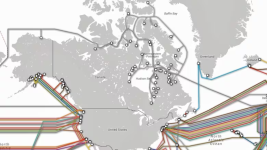- Reaction score
- 8,298
- Points
- 1,160

The US and Royal navies are manoeuvring against Russian spy platforms deep beneath the Irish Sea
The war against Putin is not ‘over there’, it’s right on our doorstep
The US and Royal navies are manoeuvring against Russian spy platforms deep beneath the Irish Sea
The war against Putin is not ‘over there’, it’s right on our doorstep
Tom Sharpe
15 November 2024 1:58pm GMT
Russian spy ship Feodor Golovin (L) being escorted by HMS Mersey (R) through the English Channel in 2018. Another Russian spy craft, the Yantar, is now operating in the Irish Sea Credit: LPhot Louise George/Royal Navy
Yesterday, the Russian spy ship Yantar was positioned over some underwater cables off the Isle of Man. The Russians call this ship a research vessel, but it isn’t. It’s part of their secret, well-funded Main Directorate of Deep-Sea Research – aka GUGI – which specialises in underwater surveillance and intelligence-gathering operations, or spying as it’s often known.
And GUGI were operating as bold as brass, in broad daylight, right in the middle of the Irish Sea. The good news is that this ship and the group she was with had been tracked for days by various nations. British frigate HMS Iron Duke was assigned to escort Russian frigate Golovko through the English Channel earlier this week before peeling off to monitor the Yantar. HMS Cattistock, a minehunter, kept tabs on the spy ship whilst the frigate was on route. Our aircraft carrier HMS Prince of Wales and RFA Proteus, our own seabed surveillance ship, are also in the Irish Sea although it’s not clear if they were involved with the Yantar this time.
Soon enough, sharp-eyed open-source intelligence spotters clocked that something was going on. An RAF P-8 Poseidon maritime patrol plane flying a tight racetrack off the northern tip of the Isle of Man was the first clue: in “peacetime” a P-8 will keep its ADS transponder switched on, meaning it can be identified and tracked by the various flight scanning websites.
Someone else then spotted a NAVTEX message warning of submarine activity in the area – NAVTEX is an international maritime safety service allowing warnings and messages to be transmitted to mariners. Again, in “peacetime” as we are now, Western navies at least will often let people know when they may have submarines in a given area: this avoids distressing incidents where a sub may run into trawler nets or other underwater equipment. In the case of trawlers this can mean being towed backwards, capsized or even dragged under.
Recently there was a long period when the Royal Navy had no attack submarines at sea at all. It’s good to see the boys are back in town.
Finally, the Yantar herself started to transmit intermittently on her Automatic Identification System (AIS), the shipping equivalent of aviation’s ADS. The Russians ought to have had this on all the time but as ever they tend to think the rules are not for them. Their AIS starting to transmit is as likely to be the result of a faulty button or someone leaning on it as any discernable posture policy: or it may have been a faked signal intended to mislead observers as to their actual position.
The Russian AIS indicated that they were stationary (and so, likely to be carrying out underwater operations) but in international waters outside the British and Irish 12-mile limits. In United Nations Convention on the Law of the Sea (UNCLOS) terms, this means that the Russians were entirely entitled to be there.
Multi-Role Ocean Surveillance Ship (MROSS) Royal Fleet Auxiliary Proteus enters Portland harbour in 2023. Proteus is the Royal Navy’s answer to Russia’s ‘Gugi’ deep-sea spying directorate, and is operating in the Irish Sea Credit: Finnbarr Webster/Getty
The US naval support ship Bruce C Heezen was in the area as well. This is interesting as not only is she an oceanographic survey ship in her own right, but it also shows the kind of excellent international cooperation on these matters that often passes unnoticed. Funnily enough, as this has played out, Vice Admiral Simon Asquith RN was co-hosting this year’s Nato resilience symposium in Slovakia discussing exactly this kind of threat.
All in all, under the Irish Sea over the last couple of days, there are likely to have been various systems and platforms prowling the deeps, and a lot of people staring into the screens of different sonars and other sensors trying to get a picture of what the other side was doing.
So, just another day in the Navy: Russian out-of-area activity met with a range of UK and international assets to monitor and deter. So far, so normal.
But there are some interesting points.
First is just how often this sort of thing is happening now. During the Cold War it was routine and we had considerable assets, and in the case of our nuclear powered submarines, considerable technical overmatch, to deal with it.
We were more proactive back then, often conducting similar activities right off their coast, albeit from underwater and never declared. And we were also more aggressive in how we dealt with their ships and equipment. The story of HMS Conqueror returning from the Falklands War, and heading directly to the High North to gnaw off a spy ship’s towed array is worth a read. I’ll come back to aggression in a bit.
The 90s and noughties saw a lull in Russian deployers coming this way but that has now well and truly ended. Russian activities in and around our Critical Underwater Infrastructure are increasing year on year whilst our ability to do anything about it remains largely unchanged. And the ‘critical’ part of that label isn’t exaggerated. These are the communications, internet, information and energy cables and pipelines that keep us alive on our island. And Russia is all over them.
The second point concerns the difficulty we have agreeing on legal responses to these sorts of grey-zone activities. It’s the same with cyber-attacks (that also happen daily). When does malfeasance become aggression and when does it become an act of war? I offer no solution to this wicked problem, we just know that Russia is good at exploiting the grey zones specifically because they know that if you play by the rules, countering them is hard.
Third, if we want to get into the grey zone ourselves, there is more we could do. The response in this case was quite traditional: crowd them out, counter-surveil, make life difficult and ultimately drive them away.
But what if we turned up the grey dial in return? A frigate’s active sonar can make an absolute racket and effectively make their ship and sensors deaf underwater. You’d need to coordinate that with your submariner chums, particularly if they were doing something ‘interesting’ themselves, but it’s simple and effective. Iron Duke is one of our Type 23s that doesn’t have the powerful towed array sonar, sadly, but the point stands.
Aggressive action against Russian underwater equipment is almost the perfect task for uncrewed submersibles deployed from a future Type 26 frigate’s mission bay. Or better still, from our very own spy ship RFA Proteus. She has huge potential in this area, but for now at least is constrained by a parent organisation – the Royal Fleet Auxiliary – that is close to breaking point in personnel terms. Nevertheless, unmanned submersibles deployed from her could cause havoc in these situations with almost none of the risk of using crewed submarines. We could end up getting far more information out of them then they get from us.
Or we could turn the dial back up even further to Cold War levels. Imagine if every time they deployed that sea-bed crawler strapped to the Yantar’s fo’c’sle, or any one of their towed arrays, they came back up not working, or better still, not there. Both our submariners and our divers would be delighted to get involved in some of that. HMS Defender had bombs dropped around her for transiting near Crimea in June 2021. Clearly, that was an absurd overreaction but it does show how differently our respective countries think about these things.
This isn’t about escalating, it’s about imposing a cost on their operations to make them question whether it’s worth it. No more free passes. It also provides a counter-messaging opportunity to challenge the brazenness of what they are doing. The Navy instinctively thinks like this, we now need the authorising political agencies to do so as well. The Red Sea has shown for a year now how ineffective playing perma-defence is in these situations.
The Navy should also be using the opportunities this affords to advertise the essential work they do on a proactive basis, not wait for OSINTers to reveal what’s going on. Again, this needs a mindset shift in Whitehall.
When the expression “pre-war” is used today, people often question what that means to us here in the UK. To me, what’s just played out in the Irish Sea is the answer. If you think about warfare in conventional terms – missiles, aircraft, boots on the ground etc – then it is still possible to regard the war in Europe as something that is “over there”. But if you think about it in asymmetric or irregular terms, then it is already happening on our doorstep, and in broad daylight.
We need to sharpen up the legal framework that enables us to deal with this and start calling it what it is – spying. We need to invest like crazy in every element of the Royal Navy and Defence that has a role in managing it, from our ships to submarines to aircraft and new tech.
This is a core role for us as a country and should feature at the very top of any priority list emerging from the current defence review. And we’re good at it, we just need more kit. In the meantime, we need to stop thinking so defensively about how to deal with it.





